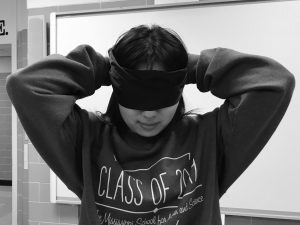Bird Box Flies Even with Expectations

By Source, Fair Use, Netflix
January 14, 2019
I watched “Bird Box” on New Year’s Eve with a group of friends seeking some second-rate entertainment with more horror than plot. (“I heard it’s very scary—has a lot of blood in it,” said my friend who owned a Netflix account.) Unfortunately, Bird Box delivered much more story—in the form of a hanging thread of mystery that leads viewers conclusively nowhere—than jump-scares and gore, but remained second-rate.
Originally, I thought the premise was clever: Paranormal entities cause the people who see them to commit suicide (by supposedly taking the form of their greatest fear), and to survive and reach a safe house, our protagonist, Malorie (Sandra Bullock), must complete a 48-hour journey down a river with two children (named Boy and Girl, because apparently everything must be scarce in a post-apocalyptic world, including creativity) while blindfolded. After finding out the story was actually adapted from a 2014 novel of the same name by Josh Malerman, though, the movie became, decidedly, less clever in my mind.
Bird Box also engendered the “Bird Box Challenge,” a meme that challenges people to perform daily tasks while blindfolded—like driving. Needless to say, accidents have occurred, reckless driving citations have been filed and Netflix recently tweeted about the challenge asking people to not be so stupid. I’m mentioning these events because they’ve soured my opinion of the movie and my hopes for humanity in general.

Putting on a blindfold as I type “Netflix… asking people not to be so stupid.”
Anyways, the majority of Bird Box is told in flashback scenes. Five years ago, the mass suicides begin, and a pregnant Malorie, after witnessing the suicide of her sister, hides in a house with a group of other survivors whose names are irrelevant because I’m trying to be succinct, and they all eventually die anyway. They decide they must cover the windows and wear blindfolds whenever they go outside. Later, the survivors discover that the suicide-causing entities have no effect on mentally deranged people, who believe the monsters are a sort of second coming. They also figure out that birds can signal when the monsters are close, by, well, going crazy. Malorie learns about the safe house down the river via radio and decides to take the children there after Tom (Trevante Rhodes), one of the other survivors who becomes her romantic partner by process of elimination, commits suicide while protecting them from a troupe of insane people. Once Malorie, the girl, who’s the daughter of one of the original survivors, and the boy, who’s Malorie’s own son, reach the safe house, they discover it’s a school for the blind.
Overall, there was nothing jarringly awful about “Bird Box,” and it managed to keep my heart rate a hair faster than normal with its pervading spooky tension.
The acting was applaudable and the characters memorable (although that’s an aspect I doubt we can commend the moviemakers for). A girl I’d watched “Bird Box” with commented that she’d read somewhere that the monsters were an extended metaphor for racism—it’s all-encompassing and destroys anyone who experiences it—but I think that’s a bit of a stretch, although it’s nice to keep in mind while watching and ponder over afterwards. There’s nothing new in “Bird Box”; essentially, a murderous stranger comes to town, a person goes on a journey and discovers what it means to love. It’s not novel or complex, but it’s still a good story, and the people who made it obviously knew what they were doing. I’d recommend it, if you’re looking to be entertained, but not if you’re searching for something “out of the box.”








